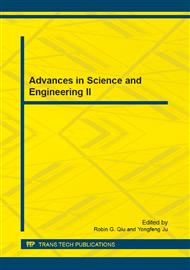[1]
T. Vicsek, A. Czirok, E. B. Jacob, I. Cohen, and O. Schochet, Novel type of phase transitions in a system of self-driven particles , Physical Review Letters, 75 (1995) 1226-1229.
DOI: 10.1103/physrevlett.75.1226
Google Scholar
[2]
R. E. Amritkar, S. Jalan , Self-organized and driven phase synchronization in coupled map networks, Physica A, 321 (2003) 220-225.
DOI: 10.1016/s0378-4371(02)01750-8
Google Scholar
[3]
Okubo A, Dynamical aspects of animal grouping: swarm schools, flocks, and herbs", Advances in Biophysics 22 (1986) 1- 94.
DOI: 10.1016/0065-227x(86)90003-1
Google Scholar
[4]
A. Jadbabaie, J. Lin and A. S. Morse, Coordination of group of mobile autonomous agents using nearest neighbor rules, IEEE Trans. On Automat. Control 48(2003) 988-1001.
DOI: 10.1109/tac.2003.812781
Google Scholar
[5]
R. M. Murray, Recent Research in Cooperative Control of Multivehicle Systems, ASME Journal of Dynamic Systems, Measurement, and Control, 129(2007) 571-583.
DOI: 10.1115/1.2766721
Google Scholar
[6]
W. Ren and R. W. Beard, Distributed consensus in multivehicle cooperative control: theory and applications, Berlin: Springer, (2008).
Google Scholar
[7]
P. Lin and Y. Jia, Distributed robust H consensus control in directed networks of agents with time-delay, Systems & control letters, 57(2008) 643-653.
DOI: 10.1016/j.sysconle.2008.01.002
Google Scholar
[8]
Y. Luo, L. Gao and F. Wang, The L2- L1 control for leader-following coordination with switching topology and time-delay, Journal of Networks, 5(2010) 1513-1520.
DOI: 10.4304/jnw.5.12.1513-1520
Google Scholar
[9]
Y. Hong, J. Hu and L. Gao, Tracking control for multiagent consensus with an active leader and variable topology, Automatica, 42(2006) 1177-1182.
DOI: 10.1016/j.automatica.2006.02.013
Google Scholar
[10]
J. Hu, and Y. Hong, Leader-following coordination of multi-agent systems with coupling time delays, Physica A, 374 (2007) 853-863.
DOI: 10.1016/j.physa.2006.08.015
Google Scholar
[11]
F. Xiao and L. Wang, Consensus problems for highdimensional multi-agent systems, IET Control Theory and Applications, 1 (2007) 830-837.
DOI: 10.1049/iet-cta:20060014
Google Scholar
[12]
L. Gao, H. Yuan and D. Jin, Consensus problems in multiagent systems with double integrator model, Chinese Physical B, 19(2010) 050520.
Google Scholar
[13]
R. Horn and C. Johnson, Matrix Analysis, New York: Cambbridge Univ. Press, (1985).
Google Scholar


